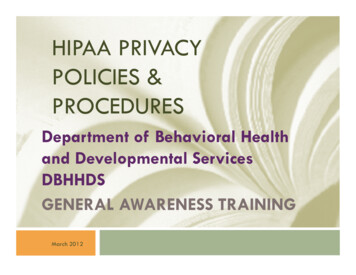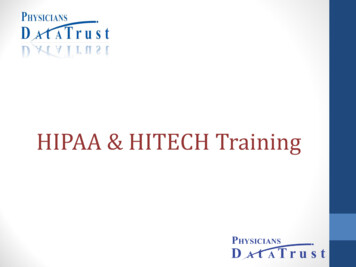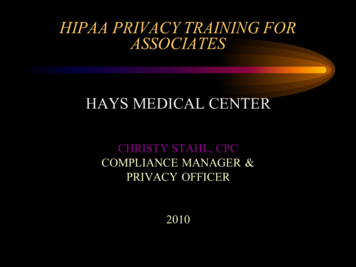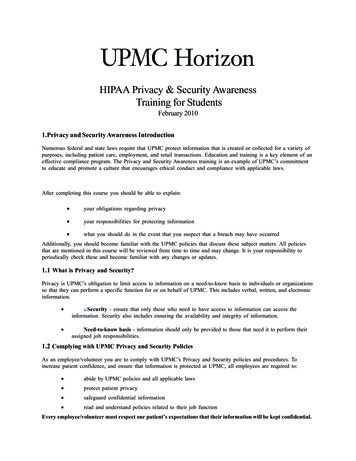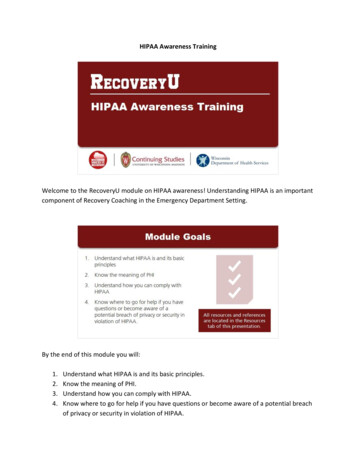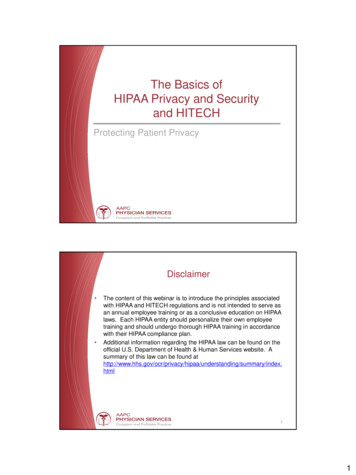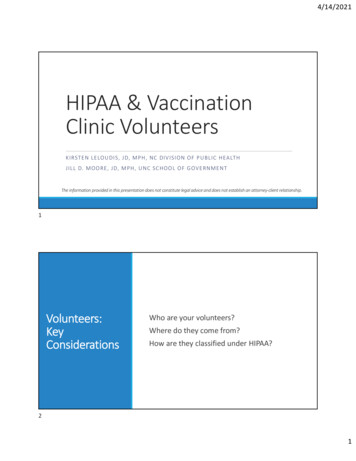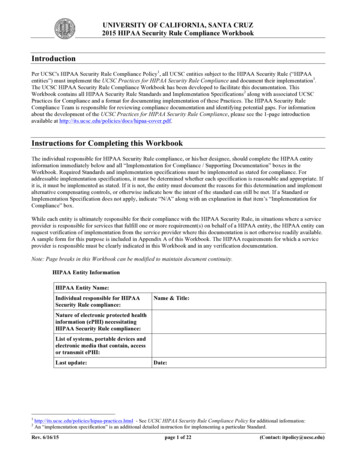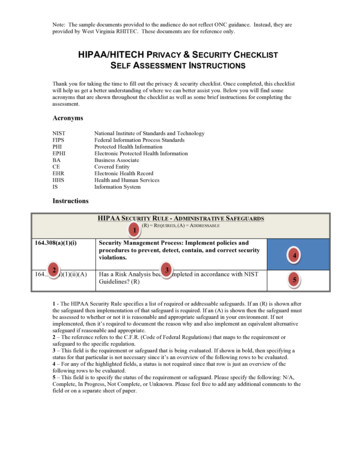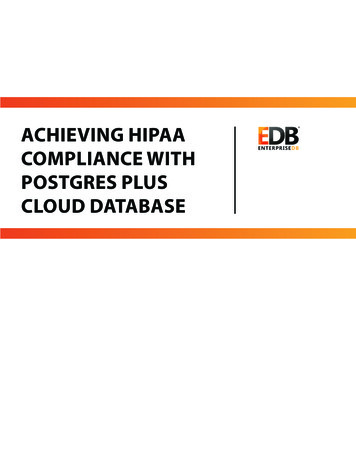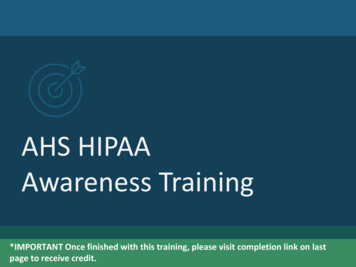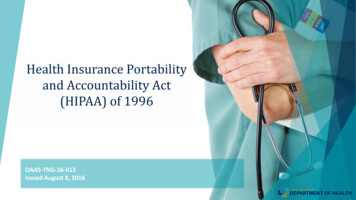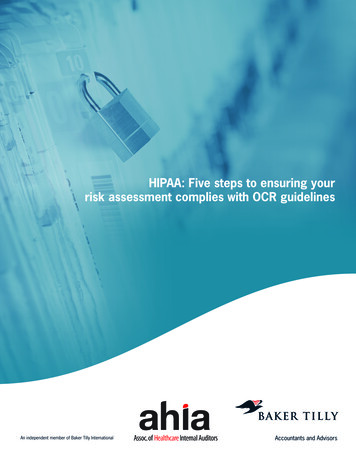
Transcription
HIPAA: Five steps to ensuring yourrisk assessment complies with OCR guidelinesAn independent member of Baker Tilly International
The information on the following pages highlights the essentialcomponents of a HIPAA risk analysis as required by the Officeof Civil Rights (OCR) and shares a cost effective approach tocompleting a risk analysis annually.
HIPAA: Five steps to ensuring your risk assessment complieswith OCR guidelinesHIPAA and healthcare technology have changed significantlyover the past 20 years. See timeline on page 5. Coveredentities and their business associates face an ever-evolvingrisk environment in which they must protect electronicprotected health information (ePHI). Although healthcaresecurity budgets may increase this year, the cost ofimplementing and maintaining adequate security controls toprotect an entity’s ePHI far exceeds what is often budgeted.As a result, some ePHI may be under-protected and vulnerableto data breach. A long-term, consistent and cost-consciousapproach to HIPAA compliance is needed.Additionally, security risk analysis must be performed in orderto comply and attest to Meaningful Use of electronic healthrecords as required by the Health Information Technology forEconomic and Clinical Health (HITECH) Act of 2009.With the OCR increasing enforcement efforts with a secondyear of random audits for both covered entities and theirbusiness associates related to HIPAA compliance, risk analysisplays a critical role. Organizations need to comply with theHIPAA risk analysis requirement if they are to be fiscallyresponsible and avoid returning Meaningful Use Medicare andMedicaid payments, avoid OCR fines and avert the cost ofbreach notification efforts.Current state of healthcareRisk analysis – Five steps to getting it rightHIPAA’s role and importance continues to rise with the valueof the data it was created to protect. Healthcare providers areincreasingly targeted by cybersecurity attacks, and patientdata now commands more than credit card accounts onthe black market and dark web. Distributed denial-of-service(DDoS), ransomware, malware, phishing and rogue softwareare frequently used in cyberattacks launched against hospitalsand other healthcare entities.Today, we find a range of compliance issues and tools usedto conduct risk analysis when providing services. Often, HIPAArisk assessment reports do not meet the guidance defined byOCR or support complete review of the security rule controls.Checklists of policies and procedures, penetration test resultsand IT assessments barely scratch the surface of the datasecurity safeguards. The wide variance in HIPAA risk analysisscope and reporting suggests that many organizations maynot truly understand the HIPAA Security Rule and how toconduct an accurate and thorough assessment of the potentialrisks and vulnerabilities to the confidentiality, integrity andavailability of ePHI held by the organization as defined by theOCR. The five steps below should put you on the right track tobe compliant with OCR guidelines.The message is clear: if you are responsiblefor securing patient and proprietaryhealthcare information, you cannotafford to be unprepared.According to the Ponemon Institute’s Sixth Annual BenchmarkStudy on Privacy & Security of Healthcare Data, nearly 90percent of surveyed healthcare organizations suffered a databreach in the past two years. The average cost of a databreach for the surveyed healthcare organizations exceeded 2.2 million. The projected cost of all data breaches for thehealthcare industry surpassed 6.2 billion.11Evaluate your current HIPAA risk assessmentThe following components should be included in your currentrisk assessment efforts: Identification of assets that create, store, process ortransmit ePHI and the criticality of the data Identification of threats and vulnerabilities to ePHI assets,the likelihood of occurrence and the impact to theorganization along with a risk ratingIn 2016 the U.S. Department of Health and Human Services(HHS) reported that over 12 million patient health recordswere breached.2 The department’s Office for Civil Rights (OCR)levied over 24 million in fines and a prison sentence wasordered for inappropriately obtaining ePHI.3 Evaluation and documentation of the administrative,physical and technical safeguards for the organization, bydepartment where applicable, and for each application withePHIRisk analysis: The foundation of an effectiveHIPAA compliance plan Evaluation and documentation of the security measurescurrently used to safeguard ePHI. Are the controlsconfigured and used properly? What are the vulnerabilities?Risk analysis is one of four required HIPAA implementationspecifications that provide instructions to implement theSecurity Management Process standard. To further clarifyrisk analysis, the OCR released guidance on the risk analysisrequirement in July 2010. The HIPAA Security Rule statesthat an organization must conduct an accurate and thoroughassessment of the potential risks and vulnerabilities to theconfidentiality, integrity and availability of ePHI held by theorganization. Evaluation of HIPAA policies and procedures – are thedocuments dated, signed, reviewed periodically andavailable?If all of the above items are not included in the scope of yourrisk assessment, the assessment may not be acceptable withan OCR audit.1
2Select the right HIPAA risk assessment toolThe OCR highlights two tools in its 2010 guidance that providea framework for risk assessment:Selecting a third-party HIPAArisk assessment partnerSecurity Risk Assessment Tool (SRA) - developed by theOffice of the National Coordinator (ONC) for HealthcareInformation Technology. The ONC’s SRA user guide walksusers through 156 questions with resources to helpunderstand the context of each question. It also allowsusers to factor in the likelihood and impact to ePHI in theorganization. The tool functions on mobile devices as well.It can be downloaded from HealthIT.gov. The tool is gearedtowards smaller practices and while a good starting point, itdoes not take into consideration many of the complexities oflarger organizations.If your organization lacks theknowledge, experience or requisitetraining to perform a HIPAA riskassessment, we recommendengaging security specialists whounderstand healthcare, healthcaretechnology and the HIPAA SecurityRule. However, it is often hard tofind all of these skills in one person.Often, it is a team of two or moreindividuals who together have thisknowledge and the right skills toprovide the best service.Risk Assessment Toolkit - developed by a team of HealthInformation Management Systems Society (HIMSS)professionals. The HIMSS Risk Assessment guide anddata collection matrix contains a PDF user guide, Excelworkbooks with NIST risk analysis references, applicationand hardware inventory workbooks, HIPAA Security Rulestandards, implementation specifications and a definedsafeguards workbook. The safeguards are numbered 1-92and correspond to the Security Scorecard workbook.The scorecard differentiates numbered safeguard componentsto be assessed for the organization, by department and withinapplications that contain ePHI. The HIMSS Risk Assessmenttoolkit is available at: -guidedata-collection-matrix. The tool includesNIST Special Publication 800-30 Revision 1 guidance forcompleting a risk assessment.When assessing resources, Understand how long the vendorhas been providing theseservices Understand the types ofcertifications and qualificationsthe vendor has Be sure the resources haveyears of experience providingsecurity, risk and complianceservices Look for qualified professionalswith certifications such as: CISA,CPHIMS, CCSFP, CISSP, HCISSP,CIPT, CISM, ISSMP or CCSFPRegardless of the tool chosen to helpwith the assessment, the most importantaspect of the risk analysis is taking anopen and honest view of the threatsand vulnerabilities to the environment.3Determine the risk analysis frequencyOne of the most prevalent challenges in complying with theHIPAA Security Rule’s risk analysis requirement is determiningthe frequency or triggering conditions for performing a riskanalysis.The HIPAA Security Rule and 2010 OCR risk analysis guidancestate that risk analysis should be “ongoing” to document andupdate security measures as needed. The security rule statesthat continuous risk analysis should be completed to identifywhen updates are needed. OCR guidance notes that thefrequency of performance will vary among covered entities.2
Some covered entities may perform these processes annually or as needed (e.g., bi-annual or every three years) depending oncircumstances of their environment. Typically, covered entities that are attesting to Meaningful Use and complying with the spiritof the security rule will conduct an annual HIPAA risk assessment.4Perform the risk assessment: insource or outsourceHIPAA does not specify who should perform the risk assessment. Some organizations insource, some outsource and some doboth – alternating between insourcing and outsourcing. For example, an organization may hire external resources to conductthe HIPAA risk assessment every other year, and on the off year the organization may choose to conduct it internally. Wherepractical, a separation of duties should exist between the HIPAA risk assessment team and the systems implementers andoperations staff. Hiring an outside professional to conduct the risk analysis reduces risk by providing an impartialassessment from someone who was not involved in the implementation of your systems or the development of yourpolicies, procedures and security controls. See sidebar for selection tips.5Support cost savings without sacrificing risk assessment qualityHow do you contain costs in performing a HIPAA risk analysis? Use an industry standard tool for assessment and stick with it.The industry standard tools also help to define a clear scope of effort. Often organizations can become disconcerted trying toconduct a self-assessment with a previous year’s report provided by an outside professional.A practical approach for risk assessmentYear 1 Conduct the assessment with anexternal professional(s) Define internal resources inyour organization and be surethey are educated on use of theassessment toolkit – make it partof the risk assessment serviceengagementYear 2 Conduct an internal selfassessment using the selectedtoolkit Consult your year one externalprofessional, should you requireguidanceYear 3 Benefit from additional costsavings beyond doing the year twoassessment internally by engagingthe same external professional(s)for the year three assessment forless cost than in year one - as longas the scope of your environmenthas remained stable The toolkit being used will befamiliar to everyone involved andprevious assessment informationwill be documented and ready forefficient review and analysis3
Final analysis: What could be missed, overlooked or found?Healthcare organizations must implement strong data security safeguards. Doing so supports compliance with the HIPAASecurity Rule, reduces risk and helps ensure the confidentiality, integrity and availability of the ePHI the organization creates,receives, maintains or transmits. Conducting internal risk analysis along with annual risk assessments that leverage aprofessional services provider every other year also reduce risk and maximize the value of the resources engaged. Finally,leveraging an industry standard toolkit will help your organization be comfortable with conducting self-assessments onalternating years while saving time and money.In providing HIPAA analysis and compliance services, we consistently find some areas of noncompliance while other areascan be unique given the size, structure or evolution of an organization. Below is a starter checklist of areas you may wantto consider when conducting your HIPAA risk analysis.How are software vendors accessing your systems?Who from the vendor team has access?Do you have a documented data classification standarddefining what ePHI is? Are all ePHI assets identified?Does this list include legacy data stores?Have you tested backups of your systems, can you trulyrestore from backups?Do you copy un-redacted production patient data toyour test or development environments? If so, whataccess and auditing controls have you put in placeto secure and monitor the test and developmentenvironments?What detective controls let you know when studentnurses, residents and volunteers with access to yoursystems are no longer engaged with your facility?Are all servers located in a physically secure datacenter? Yes, we still find servers under desks in ancillarydepartments that are often not up-to-date with currentpatches. Often this occurs in specialty areas wheresoftware specific to a department or treatment modalityis in use. A server under the desk of an ancillarydepartment is not afforded the physical, technical andenvironmental protections that your data center canprovide.Do information services staff use shared root andadministrator accounts? How often is the local Windowsadministrator account password changed?Do you have workstations or application softwarewith ePHI that have no session inactivity timeoutsset on them? Have you assessed this in all ancillarydepartments?Is HIPAA security responsibility written into youremployee job descriptions?Does your intranet collaboration site (e.g., SharePoint)contain ePHI? Often during an implementation projectdocuments are stored on a SharePoint site. At go-livescreen prints with ePHI are captured with go-live issuesdocumentation. Are screen prints with ePHI stored onyour Intranet or in email folders?Does anyone outside of information services haveadministrator rights to ePHI application software?Sources -expensive-ponemon-finds - cost of data ient-records-accessed-illegally.html - prison sentence information4
HIPAA TIMELINE1996How HIPAAevolvedThe Healthcare Insurance Portability and Accountability Act (HIPAA) was signed in August 1996.Goals of the legislation were to: improve the portability and accountability of health insurancecoverage, reduce waste, fraud and abuse in health insurance and healthcare delivery.The early to mid-2000 years saw thedevelopment of HIPAA collaboratives andcoalitions. This brought together technology,legal, clinical, security and health informationmanagement professionals to define HIPAA’simpact on their organizations, develop tools,policies and procedures to achieve HIPAAcompliance. Many organizations took HIPAA toheart and worked earnestly to be compliant,while others did not.Once HIPAA was passed, the Department ofHealth and Human Services (HHS) worked todefine the HIPAA Privacy and Security Rules.The privacy rule became effective in April,2003 and the security rule in April 2005.These rules defined what Protected HealthInformation (PHI) was, and the administrative,physical and technical security safeguards toprotect electronic health information (ePHI).HHS.gov reports that from late 2003 through 2008, there were 11,629 complaints, howeverHHS did not impose any fines for violations. The approach taken to privacy complaints was toinvestigate and recommend improvements. The number of privacy complaints trended upwardfrom 2003 to 2013. In 2014, we saw the first sharp reduction (56%) in complaints fromthe previous year, likely the result of enforcement efforts.HIPAAenforcementHITECH andthe OmnibusRule of 2013In March 2006, the HIPAA Enforcement Rule was passed to address the failure of coveredentities to fully comply with the HIPAA Privacy and Security Rules. This rule provided a means bywhich HHS could investigate and fine covered entities who neglected to implement the legislatedsafeguards. Further, the Enforcement Rule provided HHS’s OCR with the ability to convey criminalcharges against recurrent offenders who do not implement corrective measures within 30 days.Individuals also have the right to pursue civil legal action against a covered entity if their personalhealthcare information has been disclosed without their permission and it caused them to incurserious harm.Procedures to simplify the administration of health insurance became a catalyst to encouragethe healthcare industry to computerize patient medical records. HIPAA planted the seeds forthe development of the Health Information Technology for Economic and Clinical HealthAct (HITECH) in 2009, which in turn set in motion the Meaningful Use incentive program.HITECH had the goal of motivating healthcare organizations to implement and use ElectronicHealth Records (EHRs) in a meaningful way via stages of measures and Medicare and Medicaidincentive reimbursements.Within the HITECH legislation, HIPAA requirements were extended to business associates andthird-party suppliers in the healthcare industry, and the Breach Notification Rule was presented.Breach Notification stipulated that breaches of ePHI affecting more than 500 individuals must bereported to HHS – Office of Civil Rights. The criteria for reporting breaches of ePHI were definedin the Final Omnibus Rule of March 2013.The Omnibus Rule clarified the definition of a workforce within covered entities, amended thelength of time patient records could be held, covered administrative policies and proceduresfor the use of mobile devices, defined further penalties for noncompliance and reciprocalmonitoring between covered entities and their business associates.TODAY5
Baker Tilly AuthorsJanice Ahlstrom, CPHIMS, FHIMSS, CCSFP, RN, BSNDirector – Risk, Internal Audit and Cybersecurityjanice.ahlstrom@bakertilly.comKenneth Zoline, CISSPManager – Technology Risk and Cybersecuritykenneth.zoline@bakertilly.comThe Association of Healthcare Internal Auditors (AHIA) is a network of experienced healthcare internal auditingprofessionals who come together to share tools, knowledge and insight on how to assess and evaluate risk within acomplex and dynamic healthcare environment. AHIA is an advocate for the profession, continuing to elevate and championthe strategic importance of healthcare internal auditors with executive management and the Board. If you have a stake inhealthcare governance, risk management and internal controls, AHIA is your one-stop resource. Explore our website formore information. If you are not a member, please join our network, www.ahia.org.AHIA white papers provide healthcare internal audit practitioners with non-mandatory professional guidance on importanttopics. By providing healthcare specific information and education, white papers can help practitioners evaluate risks,develop priorities and design audit approaches. It is meant to help readers understand an issue, solve a problem or makea decision. AHIA welcomes papers aimed at beginner to expert level practitioners. This includes original content clearlyrelated to healthcare internal auditing that does not promote commercial products or services. Interested? Contact amember of the AHIA White Paper Subcommittee:Alan Henton, AHIA White Paper Subcommittee Chairalan.p.henton@vanderbilt.eduMark Ruppertmruppert@socal.rr.comMark Eddymark.eddy@hcahealthcare.comDebi Weatherforddebi.weatherford@piedmont.orgLinda McKeelsmckee@sentara.comTodd Havens, AHIA Board Liaisontodd.havens@vanderbilt.eduAbout Baker TillyOur healthcare expertiseBaker Tilly Virchow Krause, LLP (Baker Tilly) is a nationallyrecognized, full-service accounting and advisory firm whosespecialized professionals connect with clients and their businessesthrough refreshing candor and clear industry insight. Withapproximately 2,700 employees across the United States, BakerTilly is ranked as one of the 15 largest accounting and advisoryfirms in the country. Headquartered in Chicago, Baker Tilly is anindependent member of Baker Tilly International, a worldwidenetwork of independent accounting and business advisory firmsin 141 countries, with 28,000 professionals. The combinedworldwide revenue of independent member firms is 3.8 billion.Baker Tilly’s healthcare practice is comprised of tax, audit andadvisory professionals that work with hundreds of hospitals, healthsystems and health plans developing new strategies for growth.The team has a vast array of financial, operational and strategicexpertise covering the full spectrum of advisory services, includingvalue-based service management, risk readiness, managed-carecontracting and revenue cycle management.Connect with us:bakertilly.com/healthcare@BakerTillyUSBaker Tilly refers to Baker Tilly Virchow Krause, LLP, an independently owned and managed member of Baker Tilly International. The information provided here is of a general natureand is not intended to address specific circumstances of any individual or entity. In specific circumstances, the services of a professional should be sought. 2018 Baker Tilly Virchow Krause, LLP
Risk Assessment Toolkit - developed by a team of Health Information Management Systems Society (HIMSS) professionals. The HIMSS Risk Assessment guide and . The HIPAA Security Rule and 2010 OCR risk analysis guidance state that risk analysis should be "ongoing" to document and update security measures as needed. The security rule states
